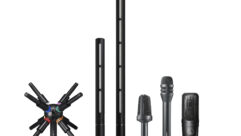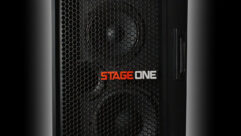
Audio Review: Barix Technology Instreamer 100, Exstreamer 100, and Annuncicom 100
Feb 1, 2009 12:00 PM,
By John McJunkin
Trio of audio-over-IP devices sport practical design and easy setup.

Barix Technology Annuncicom 100
There are myriad applications for audio-over-IP devices — virtually any application in which audio must be distributed or otherwise transmitted can benefit from the use of computer-networked audio. Switzerland’s Barix Technology — with U.S. headquarters in St. Paul, Minn. — makes a suite of audio-over-IP products that tout commercial, industrial, and security applications such as multizone audio distribution for retail, hospitality, and broadcast. More specifically, these devices can be used to provide audio for malls, grocery stores, educational institutions, and stadiums, and in broadcast applications. Although I won’t cover it in detail, one other specific application that excites me (as a podcast producer) is the notion of recording podcast content remotely. Barix’s marketing information proudly tells of the use of these units in a university setting for this purpose. I spent time with three of Barix’s products: the Instreamer 100, the Exstreamer 100, and the Annuncicom 100.
The Instreamer 100 is a network audio encoder for commercial, industrial, and security applications that converts your audio into a data stream that can be received and reproduced anywhere you’d like. The unit can stream in the MP3 (variable bit rate up to 192kbps), G.711 (µLaw/aLaw, 8kHz or 24kHz), and PCM (16-bit/8kHz or 24kHz) formats. The Exstreamer 100 is the other end of the pipe — a network audio decoder for the same applications. This device receives and plays any MP3 stream, not just those created by its Instreamer counterpart. Shoutcast, Icecast, and RTP server streams are supported as well. With separate firmware, WMA streaming is also available. Additionally, the Exstreamer features a USB slot on its front panel for playback from memory sticks. The Annuncicom 100 is a network intercom and PA system component intended for integration with the Instreamer and Exstreamer products. It transmits signals such as voice, alarms, prerecorded announcements, and music via the network to specific locations. It also facilitates paging and intercom functionality for commercial and public buildings — Barix specifies “airports, shopping malls, and remote facilities such as store chains.” In addition to facilitating live announcements by passing audio over IP, the Annuncicom facilitates relay closure for control of a door lock or some other mechanical device or indicator. This is primarily intended to facilitate a door-intercom-style application, but it could be used to accomplish any number of similar applications.
The physical containers of these Barix devices are not sexy in the sleek lines and sublime color scheme sense of the word, but their bright, practical aluminum cases are attractive in their own utilitarian way. The Instreamer 100’s front panel has a recessed reset button that returns the box to its factory settings, an RS-232 port, an infrared output, headphone jacks, and two status LEDs. The rear panel features the unit’s LAN connection, coaxial and optical S/PDIF connections, stereo RCA inputs, and power jack. This box is simple because it’s largely controlled via the network. Similarly, the Exstreamer 100’s front panel has a recessed reset button, a USB port, two status LEDs, and a headphone jack. Its rear panel has stereo RCA outputs, RS-232 and LAN ports, and a power jack. The Annuncicom 100’s front panel has a recessed reset button, an RS-232/485 port, a USB port, a mic mini jack, a monophonic RCA input and output, and two status LEDs. Its rear panel features screw terminal blocks for audio and control signal I/O, a LAN port, and power jacks. These cases are small: 4.25″×1.5″×3.1″ for the Instreamer and Exstreamer, and 4.25″×1.5″×4.92″ for the Annuncicom. The cases are all slotted for ganged installation.
Following the supplied instructions, I plugged the Instreamer 100 into my LAN router with a Cat-5 cable. Then, with headphones plugged into the headphone jack of the unit, I plugged in the power cable. After a moment, I heard a voice in my headphones reading the IP address that the unit had found and established as its own. This is a powerful feature, and it’s welcome to a person such as me who does not care much to delve into LANs, WANs, IP addresses, and other network-related stuff. I wrote down the IP address and pointed my browser to it, which immediately brought the Instreamer’s web interface to my computer screen. This interface facilitates the configuration of network, audio, streaming, I/O, control, serial port, and security parameters. Similarly, the Exstreamer’s network, streaming, play, remote, advanced, and security parameters are controlled via a web interface, as are the network, audio, streaming, I/O, control, serial, and security parameters of the Annuncicom 100. In recent years, I’ve warmed to the notion of controlling devices via a web interface, and it’s largely due to the well-planned graphical user interfaces developed by companies such as Barix. These units can be controlled by computers, web pads, PDAs, or any other web-enabled device. Another nicety: IR-enabled devices can be remotely controlled over the network with an optional stick-on transmitter.
Audio Review: Barix Technology Instreamer 100, Exstreamer 100, and Annuncicom 100
Feb 1, 2009 12:00 PM,
By John McJunkin
Trio of audio-over-IP devices sport practical design and easy setup.
I was able to successfully stream audio from both the Instreamer 100 and Annuncicom 100 and receive it with the Exstreamer 100. The quality of the audio is contingent on the settings. With high-quality audio, there is latency, but in most of the applications for which these devices would be used, latency doesn’t present a serious problem. These devices are not intended to be used as multichannel snakes for live sound or some similar application. In light of the considerable ease with which I was able to set up and configure these devices, it’s obvious to me that even a system using a great number of these devices would be simple to set up and run. It’s straightforward and documented clearly by .pdf files available from the Barix website. One minor quibble: It would be nice to have all the documentation printed and included with the units.
The Exstreamer 100 and Annuncicom 100 are individual units belonging to larger families of devices from Barix, but the Instreamer 100 is the only device in its class. I can say that if the other devices in these series are as well-planned, well-made, and simple to use, Barix is poised for great success in the future. These devices are not sexy in the traditional sense of the word, but they are highly useful and easily configured for virtually any application imaginable. I definitely recommend taking a look at them.
John McJunkin is the principal of Avalon Podcasting in Chandler, Ariz. He has consulted in the development of studios and installations and provides high-quality podcast-production services.
PRODUCT SUMMARY
- Company: Barix Technology
www.barix.com - Product: Instreamer 100, Exstreamer 100, and Annuncicom 100
- Pros: Great quality audio-over-IP solution; easily integrated.
- Cons: Making all documentation available in print would be nice.
- Applications: Commercial, industrial, and security applications.
- Price: $195 (Exstreamer 100); $395 (Instreamer 100); $395 (Annuncicom 100)
SPECIFICATIONS
Instreamer 100
- Audio formats: MP3 (up to 192kbps VBR); G.711 (µLaw/aLaw, 8kHz or 24kHz); and PCM (16-bit, 8kHz or 24kHz)
- Network interface: RJ-45, 10/100Mbps Ethernet (auto) TCP/IP, UDP, RTP, DHCP, SNMP, AutoIP, SonicIP, IPzator
- Control interfaces: DSub-9 male, 9600 baud, 3.5mm jack output for IR
Exstreamer 100
- Audio formats: MP3 (up to 320kbps fixed and VBR); G.711 (µLaw/aLaw, 8kHz or 24kHz); PCM (16-bit, 8kHz or 24kHz); and WMA (with separate firmware)
- Network interface: RJ-45, 10/100Mbps Ethernet (auto) TCP/IP, UDP, RTP, DHCP, SNMP, AutoIP, SonicIP, IPzator
- Control interfaces: DSub-9 male, 300 to 115200 baud optional IR remote kit
Annuncicom 100
- Audio formats: MP3 (up to 144kbps VBR mono); G.711 (µLaw/aLaw, 8kHz or 24kHz); and PCM (16-bit, 8kHz or 24kHz)
- Network interface: RJ-45, 10/100Mbps Ethernet (auto) TCP/IP, UDP, RTP, DHCP, SNMP, AutoIP, SonicIP, IPzator
- Control interfaces: DSub-9 male, 300 to 115200 baud, web server for control and configuration, browser based, serial port or Ethernet control API for automation systems










